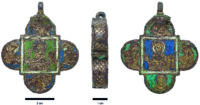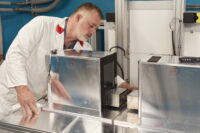 Neutron tomography has revealed fragments of bones sealed inside a 12th century reliquary pendant. The gold and enamel pendant was discovered in a medieval refuse pit in the Old City neighborhood of Mainz in 2008. It is a Greek cross with rounded ends 6 cm (2.4 inches) high and wide. It is made of gold-plated copper with enamel decoration depicting on one side Jesus in the center square with the four Evangelists in the rounded semicircular ends. The other side has Mary in the center square and four female saints on the ends. It was made in the late 12th century at a workshop in Hildesheim, Lower Saxony, in Germany.
Neutron tomography has revealed fragments of bones sealed inside a 12th century reliquary pendant. The gold and enamel pendant was discovered in a medieval refuse pit in the Old City neighborhood of Mainz in 2008. It is a Greek cross with rounded ends 6 cm (2.4 inches) high and wide. It is made of gold-plated copper with enamel decoration depicting on one side Jesus in the center square with the four Evangelists in the rounded semicircular ends. The other side has Mary in the center square and four female saints on the ends. It was made in the late 12th century at a workshop in Hildesheim, Lower Saxony, in Germany.
Only three other relic containers of this type, referred to as phylacteries, are known to date. The term phylactery is derived from the Greek term for safekeeping or protection. Their owners wore them on their bodies, usually hung around the neck.
Restorers at the Leibniz Center for Archeology (LEIZA) confirmed that it was worn as a pendant during the long conservation process when they discovered a fragment of silk cord trapped in the hanging loop. They also discovered that the locking mechanism was severely corroded and the reliquary would have been irreparably damaged in the attempt to open it.
 So instead they turned to technology to look inside the pendant. They first attempted an X-ray, but the contents of the reliquary could not be discerned. The LEIZA researchers worked with experts at the Technical University of Munich to deploy non-invasive, non-destructive neutron tomography. This revealed there were five small packets inside containing splinters of bone, presumably the relics of a saint or religious figure. Prompt Gamma Activation Analysis (PGAA) with neutrons identified the contents as silk, linen and bone.
So instead they turned to technology to look inside the pendant. They first attempted an X-ray, but the contents of the reliquary could not be discerned. The LEIZA researchers worked with experts at the Technical University of Munich to deploy non-invasive, non-destructive neutron tomography. This revealed there were five small packets inside containing splinters of bone, presumably the relics of a saint or religious figure. Prompt Gamma Activation Analysis (PGAA) with neutrons identified the contents as silk, linen and bone.
“We can’t say whether or not these bone splinters are from a saint and, if so, which one. Usually relic packages contain a strip of parchment indicating the name of the saint. In this case, however, we unfortunately can’t see one. As an archaeological research institute of the Leibniz Association, we consider it our duty to preserve the object in its historical authenticity as completely as possible for future generations and to leverage the modern opportunities of non-destructive investigation at the Technical University of Munich,” says [LEIZA restorer Matthias] Heinzel.
The restored pendant is now on display in the medieval exhibition AUREA MAGONTIA—Mainz in the Middle Ages at the Mainz State Museum.